Video Projects May Be Put on Hold, but Indies Find a Way
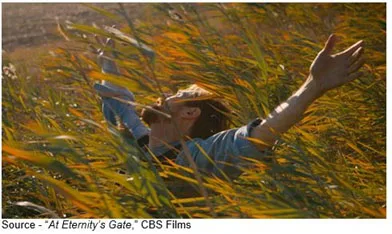
Last week we were Zooming (weird how tech names like this have become a part of our conversations) with an indie filmmaker friend when she said, “Just a few months ago, I would come home from a day on the set, open the door and my huskie would streak out and run madly around the yard. Now, if someone opens the door, I want to run out and tear around the yard.”
Things changed for folks in the M&E industry (and the rest of the world) almost overnight and PC took on a totally new meaning.
Sure, it can still mean politically correct; but today, it also marks the beginning of the new normal – post-COVID-19.
The SIP (shelter in place) and WFH (work from home) have changed business as usual everywhere but perhaps nowhere more – and more rapidly – than the content industry.
When things get tough or people want to celebrate, they always seem to turn to entertainment … escape for at least for a few hours into a parallel fun, scary, romantic, humorous, sad world that was just different from reality.
It worked in years past when people could go to the cinema, get some popcorn and jujyfruits and watch a great movie or two and feel better when they left the theater.

That entertainment stopped abruptly when medical professionals advised against (and governments prohibited) even modest gatherings.
That was okay for folks around the globe because their home and personal screens gave them access to literally any genre of video content – horror, sci-fi, romcom, history, documentary, crime, drama, fantasy, history, mystery, urban/western, political, philosophical and animated.
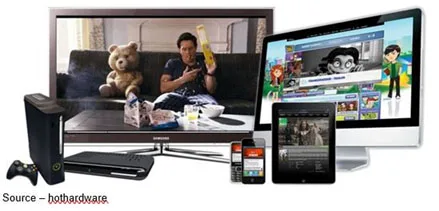
This was great news – a windfall even – for Disney, Warner, Brightlight, Fox, Universal, Breakthrough, Changchun, Imar, Pinewood, Cite du Cinema, Korda, Nu Boyana, AED, Balaji, Dhama, Argosy, Abbywinters, Estudio Quanta and the thousands of studios/streamers in every country.
After all, they had extensive libraries of movies and series for families and individuals to enjoy while they worked/studied at home.
While shrinks tell us that in uncertain times (which this has certainly been), people like to connect with the old, familiar, comfortable past.
But yesterday gets old … quick.
Studios everywhere had tentpole and good new projects completed and scheduled for release as well as stuff they rushed to complete so they could retain and attract new eyeballs and subscriptions.

But the Hollywoods of the world had to shut down immediately, forcing thousands of projects to stop – sometimes even when they were only in the scripting, cast/crew selection stage.
Others were in better shape because shooting had been completed, sets had been taken down and terabytes of RAW content were in various stages of post-production.
Sure, studio and distribution executives; as well as producers/directors/actors could weather the brief hiatus (two – six months) because they had only begun discussions about the next project, and they had salaries and financial cushions.
But they are only the tip of the M&E industry.
The waning years of the Golden Age of Hollywood (the ‘60s) were featured in Quentin Tarantino’s Once Upon a Time in Hollywood – a blend of truth with a lot of creative license.

The end of the studio system also marked the dramatic rise of the indie filmmaker – script writers, audio/video editors, colorists, CGI/VFX specialists and a huge roster of professional names you see stream across your screen at the end of every show/film that only peers and the individual watch.
In the U.S., Canada and Europe, it is estimated that there are 2M video creative/production professionals and many more in other countries.
They’re the creative nomads, members of a virtual video village, who move from project to project, turning ideas into entertainment – episodic, short, feature, ad – for the 7.8B people on the planet.
Through their associations, the upper end of the industry (major studios and celebrities) received a lot of attention and country financial support. The low budget/indie filmmaker segment (sub-$5M budgets with the lion’s share in the $10K – $100K range) received relatively little attention, even though they are responsible for most of the content produced and shown.
We thought we’d get an idea of what indies are doing during our enforced downtime after reading Alexandra Boylan’s book, Create Your Own Career in Hollywood (yes, it’s available on Amazon).
Alexandra creates an interesting and personal roadmap of how she went from a homeless actor to an award-winning film producer/writer/actor in films that have been picked up by Netflix, Universal, Pure Flix and Image Entertainment.
She chronicled her Hollywood journey and offered tips and tricks she had learned along the way.
But that was then (2017) and the landscape is dramatically different today.
In addition, we’ve been seeing a growing number of online generalist and specialist comments from pros who were lamenting projects that were on the books being cancelled until “later” or being placed on hiatus.
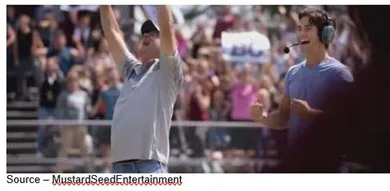
During our Zoom meeting with Alexandra, she noted that her partner (John Graham) and she had finished their sequel late last year, Catching Faith 2 (https://tinyurl.com/rvseaxg), and the two are available on Amazon Prime and iTunes.
Intent on creating strong, women-driven content, she is also active in WiF (Women in Film), Ms. In The Biz and is co-collaborator/author of Thriving in Hollywood!: Tenacious Tales and Tactics from Ms. in the Biz (https://tinyurl.com/w93sb92).
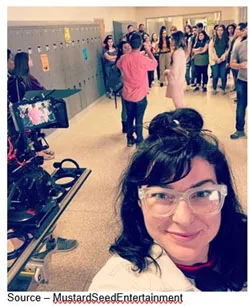
To be ready the return of life in the new normal, Alexandra is writing the script for a yet untitled inspirational family film while director, John Graham, develops the storyboards, schedule and time/financial budget for their next project, The Inheritance.
In the meantime, Alexandra and her agent are shopping their most recent project, Switched in which Cassandra Evans, who is tired of being bullied, prays that her nemesis, Katie Sharp, the queen bee of social media, would know what it’s like to walk a day in her shoes. Her prayer is answered in an unexpected way when they get Switched.
We reached out to get an update from producer Richard Levien after viewing Collisions awhile back at the Mill Valley Film Festival, where it captured the audience gold award, just to see how the film was doing and what was next on his production schedule.
While Collisions is a fictional film (https://vimeo.com/ondemand/collisions), it holds a harsh spotlight on governmental policies/actions and how people have to closely examine the devastating effects of family separation.
Produced with an all-too-typical micro crew (11 people) and equally micro budget (don’t ask). the film follows 12-year-old Itan who returns home from school with her six-year-old brother, Neto, to find their apartment ransacked and their mother, Yoana, hustled away by immigration authorities.
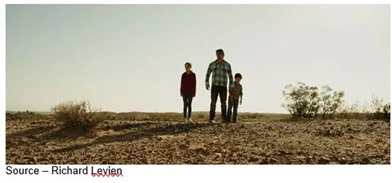
Child Services dumps the two on her estranged – and unlikeable – uncle’s doorstep. The resourceful Itan sweet talks the big rig driver, Evencio, to take them with him on his cross-country route as well as side trips to detention centers and prisons across the southwest.
The film’s journey of the children and their uncle takes them through the maddening labyrinth of immigration and detention as the three travel through the desert and its sprawl of truck stops, border patrol offices and secret immigration prisons.
A dynamic and creative storyteller, Levien delivers a film that is both gritty and authentic. He also helps his cast deliver impressive, highly emotional performances.
At the Omaha Film Festival, the film caught the attention of Kyle Whited, director of content strategy at Fuse Media, proving that film festivals are a great way to build word-of-mouth interest and global attention.

In addition to the sale to the streaming channel, the production team completed a limited revenue-share theatrical run.
After a modest exclusive showing window, the Fuse contract allowed the team to self-distribute the film through their website, www.collisionsmovie.com, and to pursue a suitable agent for international distribution.
Levien noted that self-distribution coincided with the global pandemic but hopes that the film can make a difference in a small way.
“If people are going to stream or download content, they might as well enjoy something with a message,” he said with a smile.
Despite the inability to meet face-to-face, Levien is in the early stages – phone, email, Zoom – of discussions with a national non-profit to establish a fund to help immigrant workers affected by the COVID-19 crisis with 50 percent of sales going to an immigrant worker safety net fund.
We don’t want to spoil the film for you, but we will note that the kids bring out Evencio’s better man. Still, he hits the open road, abandoning them just when it appears there’s a chance of stopping Yoana’s deportation.
You can find out the rest by downloading at collisionsmovie.com.
Another filmmaker we spoke with was Cirina Catania, chief executive of The Catania Group and a work friend for more than 10 years. Over the years, she has shot/produced documentaries on the high desert of Nevada and the infested Peruvian Amazon as well as more comfortable surroundings across the U.S., Germany, Italy, Sicily and beyond. She’s also a podcaster and sought-after speaker at professional and filmmaker user groups.
When we caught up with her, we asked her how she is handling the “workaround.”
She said the first thing that was impacted was it halted the work on her new studio in San Diego.
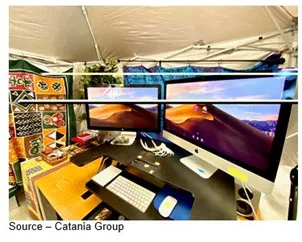
The work came to a stop when the California governor called for “isolation,” meant the carpenters couldn’t work on the build. So, she creatively housed the production system in a tent with sound muffling blankets on the wall.
With a little time on her hands, she has been doing postproduction work on three projects including her doc, Kionte’s Story, which follows the recovery (mind and body) of a young Marine corporal who had been severely wounded in Afghanistan.
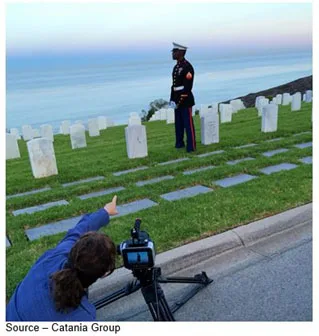
“I had to regroup and determine how I was going to keep the post work moving given the limitations of my ‘office’ and the inability to bring people into the workspace,” she noted.
“I’ve always been able to telecommute,” she commented, “so I put telecommuting/connecting into overdrive and have assistant editors working remotely. The downside of delays of shipping hard drives back and forth is minimal because there are other projects that can be edited in near realtime.”
“It’s not ideal,” she added, “but in this industry, you have to be adaptable … really adaptable!”
One of her film projects, a love story set in WWII, was set to shoot late spring in Sicily but is now on hold because of the global pandemic.
Three months ago, she spent a month in Sicily location scouting and lining up crew for the shoot. “It was a great trip”, she says, “and I got a lot organized, including finding a great crew, but we are now in wait and see mode.”

As with projects around the globe, the crew is on hold until all travel restrictions are lifted, which she feels will probably be late this fall.
“However, there is a positive side of the delay,” she continued. “I can now rewrite a commissioned theatrical script and am pretty certain my client will be able to pitch the project and, who knows, we may schedule them one after the other, which means, it will be a very busy Winter!
“It just means a huge pile of production and post work that will have to be rescheduled and prioritized,” she added. “And by then, construction on my studio will be done and the team will be able to work side-by-side … fantastic!”
We sure hope Kionte’s Story is on that list of completed work because we want to see how it ends.
Whether it’s Alexandra, Richard, Cirina or any of the other hundred or so people we know who make up the backbone of the M&E industry, the forced break in their workflow has been a mixed blessing.
Most live close to the line when it comes to annual income but the stay-at-home orders have forced them to stop (at least for a little while), finalize feature and short films they have set aside because of contract work, reorganize their digital video files, take a deep breath and realize they are making important differences and contributions to video storytelling.
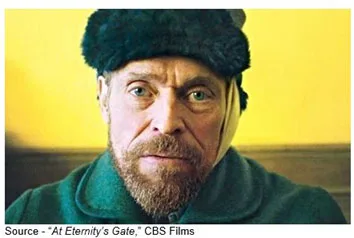 If they do, they’ll realize that Vincent Van Gogh was right when he said, “Because my vision is closer to the reality of the world, I can make people feel what it’s like to be alive.”
If they do, they’ll realize that Vincent Van Gogh was right when he said, “Because my vision is closer to the reality of the world, I can make people feel what it’s like to be alive.”
# # #
Andy Marken – [email protected] – is an author of more than 700 articles on management, marketing, communications, industry trends in media & entertainment, consumer electronics, software and applications. He is an internationally recognized marketing/communications consultant with a broad range of technical and industry expertise especially in storage, storage management and film/video production fields. This has led to the development of an extended range of relationships with consumer, business, industry trade press, online media and industry analysts/consultants.